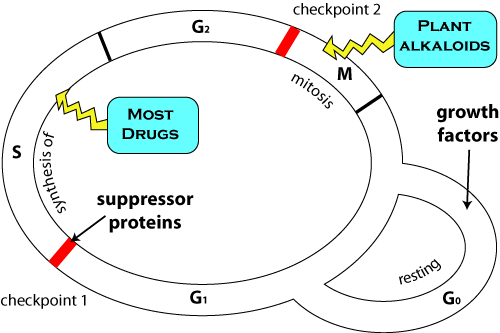

The main problem with using drugs to kill cancer cells is that cancer cells are not much different from normal cells and most of the drugs kill lots of normal cells as well as the diseased ones. Some important cancers are dependent on sex hormones (and are usually treated by removing the hormones - castration or spaying) but the only distinguishing feature of most cancer cells is that they grow more rapidly than most normal cells. Most anticancer drugs aim to disrupt cell division in some way. They usually kill all rapidly dividing cells, hopefully including the cancer cells.
Anticancer drugs are usually divided into several different groups:
Chemotherapeutic drugs are primarily used for the treatment of cancers that have metastasized to distant sites in the body or are localized but non-resectable. They are also used when potent immunosuppression is required for immune-mediated diseases (see immunosuppressives notes).
Specifically, chemotherapy is indicated in the following circumstances:
Chemotherapeutic drugs selectively kill rapidly dividing cells because they interfere with protein or DNA synthesis which is more rapid in such cells. The cells most susceptible to chemotherapeutic drugs are therefore cancer cells, cells of the haematopoietic and lymphopoietic systems and gastrointestinal mucosal cells. Fortunately, normal cells have a more rapid recovery from chemotherapeutic drug injury than neoplastic cells. Obtaining a fine balance between kill rate of host cells (toxicity) and recovery rate of tumour cells (failed therapy) is the daily challenge for vets administering chemotherapeutic drugs.
Doses of chemotherapeutic drugs are usually based on body surface area because they are so toxic that the minimum effective dose must be given (metabolic rate and therefore drug pharmacokinetics and toxicity are more closely related to body surface area than body weight - see pharmacokinetics notes). You will still find some chemotherapy doses for cats listed on a per kg basis. This is acceptable because the bodyweight range (and therefore body surface area) is very small in cats in comparison to dogs. Body surface area is usually calculated from tables or use the formula:
body surface area (m2) = wt in kg0.67/10
The same pharmacological principles apply to treatment of all neoplastic diseases, however, there are certain patterns (protocols) of drug use that maximize therapeutic success and minimize side-effects in the different neoplastic conditions. A variety of standard protocols exist for the treatment of small animal cancers. A typical protocol for the treatment of canine and feline lymphoma is included below. Intermittent dosing is preferred to continuous dosing to allow normal cells to recover.
Standard chemotherapy protocols may not suit an individual animal for a variety of reasons such as cost, idiosyncratic drug reactions, side effects, impractical administration etc. For this reason, you may have to individualise a chemotherapy protocol for an animal. Therefore you need to have some grasp of the reasoning behind chemotherapy drug protocols.
Single drug protocols are not in fashion because of resistance and efficacy with the exception of doxorubicin. It is used in cats for convenience and seems quite effective for lymphoma
Multiple drug protocols are more effective because they decrease the chance of a drug-resistant or partially resistant clone of tumour cells escaping the chemotherapy. The drugs chosen should have activity against the particular tumour (preferably proven in previously reported single-drug trials) and preferably affect cells at different stages of the cell cycle or be non-cell cycle specific (ie affect cells in all stages of the cell cycle) eg. combination of two drugs affecting the cell only during mitosis is likely to be less effective than combination of a drug that affects the cell at mitosis and a drug that strikes during DNA synthesis.
They should also have a different mode of action, not have overlapping toxicities eg. adding two markedly bone marrow suppressive drugs into the same protocol is undesirable (but sometimes necessary)and should not interact.
Another consideration is the likelihood of tumour cross-resistance. For instance, if a tumour is resistant to cyclophosphamide it will also often be resistant to chlorambucil, a closely related alkylating agent
Rapidly dividing cells exposed to anticancer drugs are under a lot of selection pressure. The main mechanism of resistance is to express P (permeability) glycoprotein on the cell surface. This actively pumps drugs out of the cell (it is a major component of the blood brain barrier) before they can cause damage. Cross resistance to the various classes of drugs occurs. Ivermectin is one of the most potent inhibitors of P glycoprotein and is undergoing trials to reverse multidrug resistance in people.
Analgesia - usually NSAIDs, especially for bone pain
Bone marrow stimulants - anabolic steroids
Appetite stimulants - benzodiazepines or steroids
Nutritional support - gastrostomy tubes
links on this page